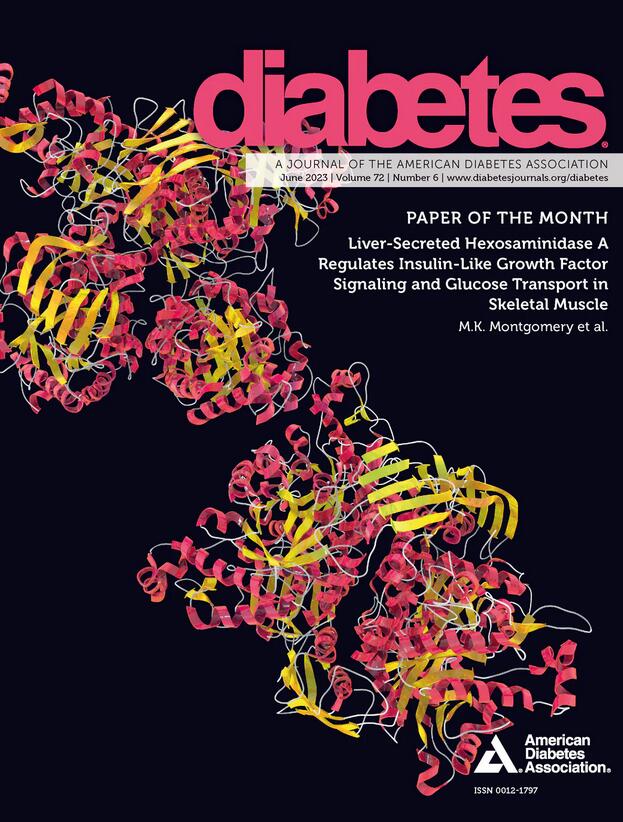1321-P: Quantifying and Adjusting for Classification Uncertainty in Type 2 Diabetes Subtypes
IF 7.5
1区 医学
Q1 ENDOCRINOLOGY & METABOLISM
引用次数: 0
Abstract
Introduction and Objective: Despite continued interest in type 2 diabetes subtypes, the challenge of uncertainty in the classification of individuals into subtypes remains. This study introduces a novel method for quantifying and adjusting for classification uncertainty in type 2 diabetes subtypes. Methods: Building on recommendations from the ADA/EASD Precision Medicine in Diabetes Initiative, we quantified individual classification uncertainty using the normalized relative entropy (NRE), computed from distances to cluster centroids. A lower NRE value indicates greater uncertainty. We examined the NRE of 859 individuals with recent-onset type 2 diabetes from the German Diabetes Study (GDS) and compared it across previously identified diabetes subtypes, defined by age, BMI, HbA1c, HOMA-IR, and HOMA-B. Predicted 10-year cardiovascular disease (CVD) risk (SCORE2-Diabetes) of the subtypes was evaluated with and without adjustment for classification uncertainty. Results: The median NRE of individuals with type 2 diabetes (age 54±10 years, BMI 31.6±6.2 kg/m2, HbA1c 6.4±0.9%) was 0.127 (95% CI: 0.119-0.135). Individuals with mild age-related diabetes (n=395) and mild obesity-related diabetes (n=316) had a median NRE of 0.155 (95% CI: 0.142-0.177) and 0.119 (95% CI: 0.107-0.131). By contrast, individuals with severe insulin-resistant diabetes (n=130) and severe insulin-deficient diabetes (n=18) had a lower median NRE of 0.086 (95% CI: 0.075-0.108) and 0.082 (95% CI: 0.071-0.109). After adjustment, the proportion of variation in SCORE2-diabetes explained by the subtypes (R2) increased from 17.4% (95% CI: 12.8-23.0) to 31.5% (95% CI: 26.4-37.1). The predicted 10-year CVD risk of the mild age-related diabetes subtype increased from 10.3% (95% CI: 9.8-10.7) to 11.6% (95% CI: 11.2-12.0). Conclusion: Classification uncertainty varied between subtypes and individuals with type 2 diabetes, and adjusting for it improved the ability of the subtypes to predict 10-year CVD risk. Disclosure T. Mori: None. O.P. Zaharia: None. K. Strassburger: None. J.M. Dennis: None. M. Roden: Research Support; Boehringer-Ingelheim. Advisory Panel; Echosens. Speaker's Bureau; Madrigal Pharmaceuticals, Inc. Advisory Panel; MSD Life Science Foundation. Board Member; Novo Nordisk. Advisory Panel; TARGET PharmaSolutions, Inc. R. Wagner: Speaker's Bureau; Boehringer-Ingelheim, Novo Nordisk. Advisory Panel; Sanofi. Speaker's Bureau; Sanofi. Advisory Panel; Lilly Diabetes. O. Kuss: None.1321-P: 2型糖尿病亚型分类不确定性的量化和调整
简介和目的:尽管对2型糖尿病亚型的研究持续受到关注,但个体亚型分类的不确定性仍然存在。本研究介绍了一种量化和调整2型糖尿病亚型分类不确定性的新方法。方法:基于ADA/EASD糖尿病精准医学倡议的建议,我们使用归一化相对熵(NRE)来量化个体分类的不确定性,从到聚类质心的距离计算。NRE值越低,不确定性越大。我们检查了来自德国糖尿病研究(GDS)的859例新近发病的2型糖尿病患者的NRE,并将其与先前确定的糖尿病亚型进行了比较,这些亚型由年龄、BMI、HbA1c、HOMA-IR和HOMA-B定义。预测10年心血管疾病(CVD)风险(score2 -糖尿病)的亚型进行评估,调整和不调整分类不确定性。结果:2型糖尿病患者(年龄54±10岁,BMI 31.6±6.2 kg/m2, HbA1c 6.4±0.9%)的中位NRE为0.127 (95% CI: 0.119-0.135)。轻度年龄相关性糖尿病(n=395)和轻度肥胖相关性糖尿病(n=316)患者的中位NRE分别为0.155 (95% CI: 0.142-0.177)和0.119 (95% CI: 0.107-0.131)。相比之下,严重胰岛素抵抗型糖尿病(n=130)和严重胰岛素缺乏型糖尿病(n=18)患者的NRE中位数较低,分别为0.086 (95% CI: 0.075-0.108)和0.082 (95% CI: 0.071-0.109)。调整后,score2 -糖尿病中由亚型解释的变异比例(R2)从17.4% (95% CI: 12.8-23.0)增加到31.5% (95% CI: 26.4-37.1)。轻度年龄相关糖尿病亚型的10年CVD预测风险从10.3% (95% CI: 9.8-10.7)增加到11.6% (95% CI: 11.2-12.0)。结论:2型糖尿病不同亚型和个体之间的分类不确定性存在差异,对其进行调整可提高亚型预测10年CVD风险的能力。T. Mori:没有。O.P.扎哈里亚:没有。K.斯特拉斯堡:没有。J.M.丹尼斯:没有。M. Roden:研究支持;勃林格殷格翰集团。顾问小组;Echosens。演讲者的局;马德里加尔制药公司顾问小组;生命科学基金会。董事会成员;诺和诺德公司。顾问小组;塔吉特制药解决方案公司R. Wagner:发言人局;勃林格殷格翰,诺和诺德。顾问小组;赛诺菲。演讲者的局;赛诺菲。顾问小组;莉莉糖尿病。O. Kuss:没有。
本文章由计算机程序翻译,如有差异,请以英文原文为准。
求助全文
约1分钟内获得全文
求助全文
来源期刊

Diabetes
医学-内分泌学与代谢
CiteScore
12.50
自引率
2.60%
发文量
1968
审稿时长
1 months
期刊介绍:
Diabetes is a scientific journal that publishes original research exploring the physiological and pathophysiological aspects of diabetes mellitus. We encourage submissions of manuscripts pertaining to laboratory, animal, or human research, covering a wide range of topics. Our primary focus is on investigative reports investigating various aspects such as the development and progression of diabetes, along with its associated complications. We also welcome studies delving into normal and pathological pancreatic islet function and intermediary metabolism, as well as exploring the mechanisms of drug and hormone action from a pharmacological perspective. Additionally, we encourage submissions that delve into the biochemical and molecular aspects of both normal and abnormal biological processes.
However, it is important to note that we do not publish studies relating to diabetes education or the application of accepted therapeutic and diagnostic approaches to patients with diabetes mellitus. Our aim is to provide a platform for research that contributes to advancing our understanding of the underlying mechanisms and processes of diabetes.
 求助内容:
求助内容: 应助结果提醒方式:
应助结果提醒方式:


